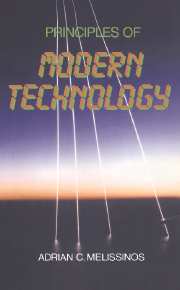7 - Airplane and rocket flight
Published online by Cambridge University Press: 03 December 2009
Summary
Fluid flow and dynamic lift
The motion of a fluid is extremely complex because the individual molecules are subject to random thermal motion as well as to the collective motion of the fluid as a whole. Thus we consider a small element dτ of the fluid and follow its motion as a function of time. We will assume that the fluid is incompressible, so that the mass dm = ρ dτ contained in the volume dτ remains fixed and the density ρ is constant throughout the fluid; we will also assume that the fluid is non-viscous, that is there are no internal frictional forces. These two assumptions are applicable to motion through air when the velocity v is small as compared to the velocity of sound vs, i.e. v « vs. The velocity of sound is a measure of the random thermal velocity of the molecules; its value for air at s.t.p. is vs ≃ 330 m/s. When necessary we will relax these assumptions.
The simplest form of flow occurs when the velocity at each point of the liquid remains constant in time. This is illustrated in Fig. 7.1(a) where the element dτ follows the path from the point P to Q to R and has the velocity vP, vQ, vR; at a later time another element of the fluid will be at P but it will again follow the path to Q to R and have the same velocity.
- Type
- Chapter
- Information
- Principles of Modern Technology , pp. 241 - 275Publisher: Cambridge University PressPrint publication year: 1990



